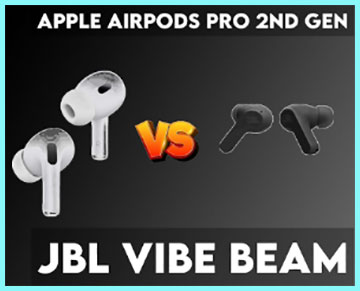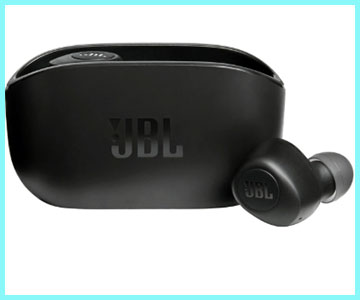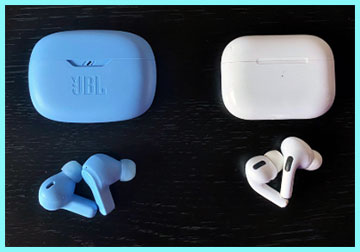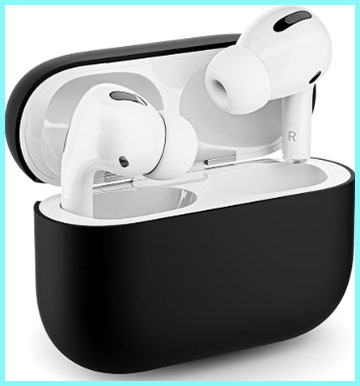This article is all about helping you decide between two very different, yet equally tempting, true wireless earbuds: the JBL Vibe Beam and the Apple AirPods.
I’m going to share my real-world experience and get into the specifics of what makes each of these products tick, so you can confidently pick the right sound companion for your lifestyle and budget. By the time we’re done, you will have a clear understanding of the key differences, allowing you to choose the earbuds that perfectly match your needs.
A Brief Comparison Table
| Feature | JBL Vibe Beam | Apple AirPods (Standard, Latest Gen) |
| Form Factor | In-Ear (Stick-Closed Design with silicone tips) | Semi-Open (One-size-fits-all bud without silicone tips) |
| Driver Size | 8mm Dynamic Driver | Custom High-Excursion Apple Driver |
| Sound Signature | JBL Deep Bass Sound | Balanced, clear with Adaptive EQ |
| Active Noise Cancellation (ANC) | No (Some models/versions may offer it, but the base Vibe Beam does not) | No (Only on Pro models) |
| Ambient/Transparency Mode | Yes (Smart Ambient with TalkThru) | Yes (Transparency Mode) |
| Total Battery Life (with Case) | Up to 32 Hours (8 hours in buds + 24 in case) | Up to 30 Hours (up to 6 hours in buds) |
| Water Resistance (Earbuds) | IP54 (Dust and Water Resistant) | IPX4 (Sweat and Water Resistant) |
| Voice Assistant | Yes (Via JBL App/Touch) | Yes (Always-on “Hey Siri” functionality) |
| Seamless Ecosystem | Universal Bluetooth Connection | Exclusive to Apple Devices (H1/H2 Chip Integration) |
| Charging | USB-C | Lightning or USB-C (Case dependent) |
| Price Point | Budget-Friendly | Premium |
My Experience With JBL Vibe Beam
When I first unboxed the JBL Vibe Beam, I was immediately struck by the robust feel of both the earbuds and the charging case. For the price point, they feel remarkably solid. The “stick-closed” design means they sit snugly in the ear canal, creating a passive seal which is crucial for maximizing sound quality, especially the bass. I’ve used them on countless commutes and workout sessions, and they’ve proven to be a reliable and consistent performer, especially for people who love music with a strong rhythmic foundation.

The first thing anyone notices with a JBL product is the sound, and the Vibe Beam is no exception. They deliver on the promise of “JBL Deep Bass Sound.”
I found the low-end frequencies to be rich, punchy, and substantial without completely muddying the mids or highs.
For rock, hip-hop, and electronic music lovers, this sound profile is an absolute win.
The JBL Headphones App is a massive bonus here, as it allowed me to tweak the EQ settings.
I was able to dial back the bass slightly for a more balanced sound when listening to podcasts or acoustic tracks, demonstrating a surprising level of customization that I genuinely appreciate.
Battery life on the Vibe Beam has been one of the biggest pleasant surprises. Getting a solid eight hours from the earbuds alone is fantastic for long days, and the case easily stretches that to a full 32 hours. I rarely find myself scrambling for a charger. The IP54 rating has also given me peace of mind; I’ve worn them in light rain and during intense sweaty gym sessions without a single hiccup.
The Smart Ambient features—TalkThru and Ambient Aware—are functional, allowing me to chat briefly with a cashier or hear traffic without pulling the buds out. While not as refined as some higher-end systems, they absolutely get the job done for safety and convenience. Overall, the JBL Vibe Beam is a genuine powerhouse for its category, proving that great audio doesn’t have to break the bank.
Read More: Comparison Of Tozo T6 Vs. Airpods
Pros Of JBL Vibe Beam
- Exceptional Battery Life: The sheer longevity of the power is a standout feature, giving you a full eight hours of playback in the earbuds themselves and up to 32 total hours with the charging case. This means you can power through multiple workdays or long travel periods without needing to find an outlet, drastically reducing any battery anxiety I used to have with other earbuds. The quick charge feature is also incredibly useful, providing two hours of play from just a ten-minute charge—perfect for those frantic mornings when I’m running out the door.
- Customizable Deep Bass Sound: If you enjoy music with a palpable low-end, the 8mm drivers and JBL Deep Bass Sound deliver a satisfyingly punchy and immersive audio experience. What elevates this further is the accompanying JBL Headphones App, which allows me to fully customize the equalization (EQ). I can fine-tune the bass, mid-range, and treble to my exact preference, which is an invaluable feature for anyone who listens to a diverse range of music genres or simply prefers a specific sound profile that goes beyond the default factory tuning.
- Superior Durability and Water Resistance: The earbuds carry an IP54 rating, making them highly resistant to both dust and water splashes. This level of protection makes them ideal for various rugged activities; I have used them extensively while cycling in light drizzle and during exceptionally sweaty workouts at the gym, and they have performed flawlessly, giving me the confidence that they can handle my active lifestyle much better than non-rated competitors.
- Secure and Comfortable In-Ear Fit: The ergonomic “stick-closed” design with interchangeable silicone eartips (three sizes included) ensures a secure and comfortable fit that creates an excellent passive seal. This tight seal is a dual-purpose benefit, as it not only helps to keep the earbuds firmly in place during movement but also significantly enhances the bass performance and passively blocks out a noticeable amount of external ambient noise, greatly improving the overall immersion.
- Smart Ambient Technology for Awareness: The built-in Smart Ambient features, specifically Ambient Aware and TalkThru, are excellent additions for real-world usability. Ambient Aware lets in surrounding noise, keeping me safe and aware of traffic or announcements while I’m out, while TalkThru instantly lowers the music volume and amplifies voices, allowing me to have quick, natural conversations with a barista or colleague without the annoyance of having to remove my earbuds.
- Significantly More Affordable Price Point: The JBL Vibe Beam offers a remarkable feature set and sound quality that punches well above its weight, particularly when you consider its highly competitive and budget-friendly price. This makes them a fantastic choice for cost-conscious consumers or for those who want a high-performing pair of everyday earbuds without having to commit to the premium expenditure associated with the Apple brand name.
- Universal Compatibility with All Devices: Unlike the deep integration of the Apple AirPods that favors Apple devices, the JBL Vibe Beam uses standard Bluetooth 5.2, ensuring a reliable and excellent connection with virtually any Bluetooth-enabled device, including Android smartphones, Windows laptops, and various other media players. This broad, universal compatibility means you aren’t locked into a single ecosystem, giving you freedom of choice in your other devices.
Cons Of JBL Vibe Beam

- Absence of True Active Noise Cancellation (ANC): While the ‘stick-closed’ design provides decent passive noise isolation due to the physical seal, the base model of the JBL Vibe Beam lacks a dedicated, true Active Noise Cancellation (ANC) feature. This omission means they can’t effectively filter out persistent, low-frequency sounds—like the rumbling of an airplane engine or constant traffic noise—as well as earbuds that do have dedicated ANC, making them a less ideal choice for people who commute regularly on public transport or frequently fly.
- Bulkier Design and Fit: Compared to the sleek, one-size-fits-all, semi-open design of the standard Apple AirPods, the Vibe Beam, with its in-ear tip requirement and overall chunkier build, can feel slightly bulkier in the ear. While they are comfortable for my ear shape, people with smaller ear canals have often reported a feeling of pressure or mild discomfort after extended listening sessions, and the case itself is somewhat less streamlined and pocket-friendly than the smaller, minimalist AirPod case.
- Microphone Performance is Just Adequate: For casual calls in a quiet environment, the dual microphones perform fine and I have no complaints, but when I move to a noisier setting, such as a busy street or a bustling café, the microphone’s ability to isolate my voice degrades. Callers on the other end have reported hearing a significant amount of background noise and distortion, meaning the Vibe Beam isn’t the best choice for professionals who rely on consistently crisp and clear voice calls throughout their day in varying noisy conditions.
- JBL App Connection Can Be Finicky: Although the dedicated JBL Headphones App offers valuable customization options for EQ and ambient control, I have occasionally experienced minor connection quirks. Sometimes the app takes a moment to recognize the earbuds, or it needs to be opened to ensure the chosen custom settings are correctly applied, which can be a small, but noticeable, friction point in what should be a completely seamless user experience.
- Sound Profile is Heavily Bass-Forward: While I listed the powerful bass as a positive for many users, the ‘JBL Deep Bass Sound’ signature can be overwhelming for some people, especially those who prefer a completely flat, neutral, or highly analytical sound reproduction. Even with the in-app EQ customization, the default tuning is so bass-heavy that listeners of classical music, jazz, or audiobooks may find the low-end presence distracts from the subtler details in the mid-range and high-end frequencies.
- No Automatic Ear Detection: A common feature in many modern true wireless earbuds, including Apple’s, is the ability to automatically pause the music when an earbud is removed and resume when it is put back in. The JBL Vibe Beam lacks this specific feature. I find myself having to manually pause my audio via the touch controls or my phone, which is a minor inconvenience but noticeable when I am used to the seamless, hands-free operation of other earbuds.
- Touch Controls Can Be Overly Sensitive or Delayed: The touch controls on the Vibe Beam, while highly configurable within the app, sometimes prove to be a bit frustrating in practice. On one hand, a slight brush or adjustment of the earbud can accidentally trigger a command like skipping a track or hanging up a call. On the other hand, a deliberate tap sometimes has a noticeable, momentary delay before the action registers, which occasionally leads me to tap again, resulting in an unintended double command.
My Experience With Apple AirPods
The moment I started using the Apple AirPods (I’m focusing on the latest standard generation here, not the Pro model), I understood what people meant by ‘seamless integration.’ If you live in the Apple ecosystem, these earbuds are simply magic. The setup process is ridiculously fast—just open the case near your iPhone, and they’re connected. The instant switching between my iPhone, iPad, and MacBook Pro is the kind of convenience that you don’t realize you need until you experience it.

Unlike the JBL Vibe Beam, the standard AirPods feature an open-style, hard-plastic design without silicone tips.
For my ears, this fit is incredibly light and comfortable, often making me forget I’m wearing them.
However, it’s a one-size-fits-all approach, and I know many friends who find them loose or uncomfortable, especially during vigorous activity.
They are definitely not for everyone’s ear shape.
In terms of sound, the AirPods are designed for a wide audience. They offer a clear, bright, and well-balanced sound profile. The Adaptive EQ does a great job of tuning the music to the shape of your ear in real time, which is a clever piece of tech. While the bass is present and clean, it lacks the deep, physical punch of the JBL Vibe Beam.
I found them to be excellent for podcasts, voice calls, and casual listening, where clarity in the mid-range is paramount. The ‘Hey Siri’ function is flawless, making hands-free control effortless, and the Transparency Mode is arguably the best in the business, sounding completely natural as if I had nothing in my ears at all. They might be pricier, but the unique features and the sheer convenience of the Apple experience truly distinguish them.
Pros Of Apple AirPods
- Unrivaled Ecosystem Integration and Seamless Pairing: The most significant advantage of the Apple AirPods is the effortless and almost instant connectivity within the Apple ecosystem, thanks to the integrated Apple H-series chip. Pairing is a matter of flipping open the case near an Apple device, and they’re instantly ready to go. Furthermore, the automatic switching feature is a true game-changer, allowing me to seamlessly move from listening to music on my iPhone to joining a conference call on my MacBook Pro without manually going into any Bluetooth settings.
- Industry-Leading Transparency Mode and Adaptive EQ: The AirPods’ Transparency Mode is, in my opinion, the gold standard for blending your audio with the outside world. The sound of the environment is piped in so naturally that it genuinely feels as though you are not wearing earbuds at all, which is perfect for maintaining awareness or engaging in conversations. The Adaptive EQ technology also uses internal microphones to tune the sound profile in real time based on the fit in your ear, ensuring consistent and optimized audio performance.
- Hands-Free Control with ‘Hey Siri’ and Voice Isolation: The ability to simply say “Hey Siri” for instant, hands-free access to calls, music control, directions, and device functions is a convenience I use constantly and rarely find on non-Apple products. Coupled with the advanced beam-forming microphones and computational audio, the AirPods deliver superb call clarity, actively isolating my voice from background noise much more effectively than the Vibe Beam, making them my preferred choice for important calls on the go.
- Sleek, Iconic, and Ergonomically Lightweight Design: The distinct, semi-open, hard-plastic design of the standard AirPods is instantly recognizable and incredibly lightweight. For people whose ear canals find silicone tips uncomfortable or irritating, this hard-plastic shell provides a relief and a comfortable fit that can be worn for hours. They also have an IPX4 rating, meaning they are perfectly capable of handling rain and sweaty workouts without issue.
- Spatial Audio with Dynamic Head Tracking: This is an immersive audio experience feature that allows for a multidirectional, theater-like soundstage that changes based on your head’s movement, making the audio feel like it’s coming from the screen of your device. This feature significantly enhances the experience of watching movies, TV shows, and supported music tracks, transforming a regular listening session into a captivating, three-dimensional auditory event.
- Intuitive and Reliable Force Sensor Controls: Instead of sensitive touch panels that can misfire, the standard AirPods use a force sensor integrated into the stem, which requires a deliberate squeeze. This control mechanism is incredibly reliable, almost completely eliminating accidental taps and providing satisfying, tactile feedback for controls like play/pause, skip, and answering calls, making interaction seamless and frustration-free.
- Integration with Apple’s Find My Network: Should you misplace your earbuds, the integration with Apple’s Find My network provides peace of mind. This feature can pinpoint the last known location of your AirPods on a map, and for closer range, it can even play a loud sound or use Precision Finding (on supported devices) to guide you directly to the case, an advantage that JBL, as a third-party brand, simply cannot offer.
Cons Of Apple AirPods

- Premium Price Tag is Significantly Higher: The most immediate and undeniable drawback of the Apple AirPods is the premium price point, which is substantially higher than the JBL Vibe Beam. You are essentially paying a significant premium for the Apple brand, the seamless ecosystem integration, and the proprietary chip technology. This high cost can be a major barrier for budget-conscious buyers or for anyone who feels the incremental feature upgrades don’t justify the increased expense.
- Lack of Deep Bass and Customizable Sound: The audio signature of the standard AirPods is generally clear, bright, and well-balanced, but it noticeably lacks the deep, resonant bass that many music lovers crave, especially compared to the ‘JBL Deep Bass Sound’ of the Vibe Beam. Furthermore, there is no native, user-accessible EQ customization, meaning you are locked into Apple’s default sound tuning and cannot tweak the audio profile to suit your personal tastes or specific music genres.
- One-Size-Fits-All Design and Poor Passive Isolation: The semi-open, hard-plastic design is a major point of contention, as it either fits perfectly or not at all—there is no in-between, and there are no interchangeable silicone tips to adjust the fit. For many users, this results in a loose, insecure fit that is prone to falling out during movement. Crucially, this design provides almost no passive noise isolation, meaning a great deal of external sound leaks in, forcing you to rely entirely on the Transparency Mode which is intended for awareness, not immersion.
- Ecosystem Lock-In and Reduced Android Functionality: While the seamless integration is a huge pro for Apple users, it represents a significant con for anyone using an Android device or other non-Apple platforms. Many of the most advanced features—such as automatic device switching, “Hey Siri,” and advanced battery status—either don’t work or are severely limited on non-Apple operating systems, meaning Android users would be paying a premium for a highly diminished user experience.
- Subpar Battery Life Compared to Competitors: The up to six hours of listening time per charge for the earbuds themselves, while manageable for daily use, is demonstrably shorter than the eight hours offered by the JBL Vibe Beam and many other competitors in the market. This shorter playback time requires more frequent returns to the charging case, which can be particularly inconvenient during long flights, extended work periods, or if you simply forget to pop them back in the case when not in use.
- No Physical Noise Blocking (Non-Pro Models): Due to the open-fit design, the standard AirPods offer absolutely no physical barrier to noise. Unlike the Vibe Beam which at least has passive noise isolation from its silicone tips, all external sound, whether it’s chatter, traffic, or loud machinery, comes through clearly. This makes them significantly less effective than sealed earbuds, even those without ANC, for creating a focused and distraction-free listening environment.
- Vulnerability to Loss and Damage: The sleek, smooth plastic body of the AirPods, combined with the hard, non-sealing ear fit, makes them inherently more susceptible to falling out and becoming damaged or lost compared to in-ear earbuds with a silicone seal. The high replacement cost for a single lost AirPod or the charging case adds a persistent, low-level financial worry that is not nearly as pronounced with a more affordable and more physically secure option like the JBL Vibe Beam.
Also Read: Comparison Of Jabra Elite 75t Vs. Elite 7 Pro
Frequently Asked Questions (FAQ)
This depends entirely on your priority and budget. If you prioritize deep, customizable bass sound, superior battery life, rugged durability, and a much lower price point that works with all devices, then the JBL Vibe Beam is better for you. If you prioritize flawless ecosystem integration with Apple devices, the best-in-class Transparency Mode, hands-free Siri, and superior call clarity, and you are willing to pay a premium price, then the AirPods are better for you.
For a user who values strong bass performance, long battery life (8 hours per charge on the buds), IP54 dust and water resistance, and the ability to customize the sound via an app—all for a significantly lower cost—the JBL Vibe Beam is arguably the better value and a superior choice. However, if your primary device is an iPhone and you require the seamless switching and iconic form factor, the AirPods offer a better proprietary user experience.
The JBL Vibe Beams are very good for their price point, offering a compelling blend of features and audio quality. They deliver the signature JBL Deep Bass Sound, boast an excellent total battery life (up to 32 hours), are IP54-rated for daily durability, and include practical features like Smart Ambient/TalkThru and full EQ customization through the dedicated app. They are an exceptional choice for the average music enthusiast who is budget-conscious.
Absolutely, yes. The JBL Vibe Beams use standard Bluetooth 5.2 technology, which ensures complete compatibility with any iPhone, iPad, Mac, or any other Bluetooth-enabled device (Android, Windows, etc.). While you won’t get the proprietary H-chip features like automatic device switching that AirPods have, all core functions, including music playback, hands-free calling, and app customization, work perfectly well with the iPhone.
Conclusion
If your search has been for a pair of true wireless earbuds that prove you don’t have to mortgage your future for fantastic audio, then the JBL Vibe Beam should be your pick. I can confidently tell you that you will be impressed by the lasting power, the powerful sound, and the sheer value for money these offer. They are the champion for the bass enthusiast and the pragmatic buyer who needs an earbud that performs reliably across the board without the Apple premium. You are getting a durable, long-lasting audio companion that you can truly customize to your liking.
For those of you who already have an iPhone, an iPad, or a MacBook, I really believe you’ll find that the true value of the Apple AirPods is not just in the sound quality, but in the unmatched convenience and effortless experience they bring to your daily digital life. The seamless connection, the magical device-switching, and the perfect Transparency Mode are features no third-party competitor can genuinely replicate. You are investing in a premium, integrated experience that will make your life simpler and your hands-free calls clearer, especially if you appreciate the lightweight, open-ear design.
